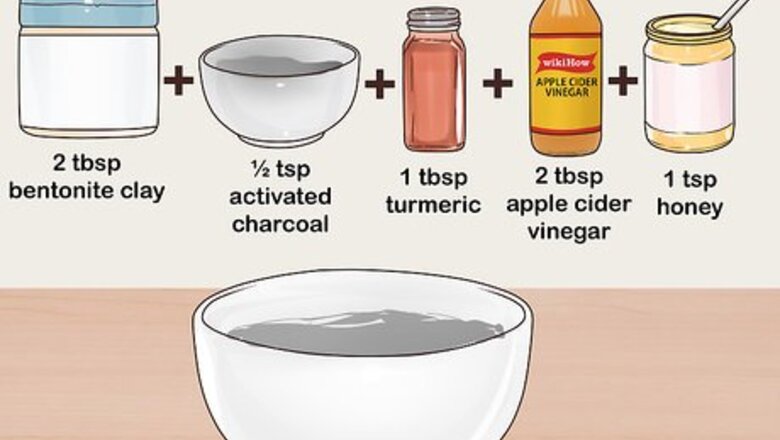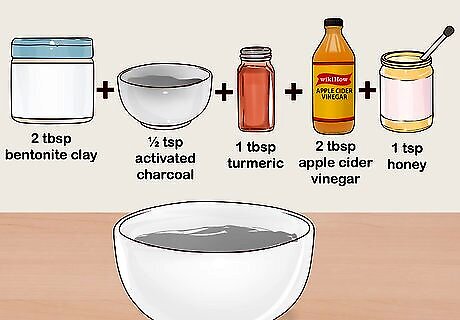
views
Making the Charcoal
Build a medium-sized fire in a safe area. An outdoor fire will likely be the easiest for making activated charcoal, but you can also do this in your home fireplace. The fire should be hot enough to cause wood pieces to burn. Take safety precautions when lighting a fire and always keep a fire extinguisher nearby.
Pack a metal pot with small pieces of hardwood. If hardwood is not available, you can substitute almost any dense, fibrous plant material, like coconut shells. Insert your hardwood pieces or plant material into a metal pot, then cover it with a lid. The lid of your pot should have a vent hole, though airflow to the inside of the pot should be limited throughout this process. You could use a camp cookware kettle so the air can escape through the spout, for instance. The material you burn should be as dry as possible before you put it in the pot.
Cook the pot on an open fire for 3 to 5 hours to make charcoal. Set the lidded pot on the fire. As the material cooks, you should see smoke and gas escape from vent hole in the lid. Doing this will burn away everything from the material except the carbon (charcoal) in it. When no more smoke or gas seems to be coming from your pot, it’s likely finished cooking.
Clean the charcoal with water once it cools. The charcoal now in your pot will stay hot for a while. Give it plenty of time to cool down. When it’s cool to the touch, transfer the carbon to a clean container and rinse it with cool water to remove ash and any remaining debris, then drain the water.
Grind up the charcoal. Transfer the cleaned charcoal to a mortar and pestle and grind it up into a fine powder. Alternatively, you could put the carbon in a durable plastic bag and crush it up into a fine powder with a tenderizing mallet or a hammer.
Allow the charcoal powder to air dry completely. If you used a plastic bag, transfer the powder to a clean bowl, otherwise you can leave it in the mortar. In about 24 hours, the powder should be dry. Confirm the dryness with your fingers; the powder should be fully dry before you move on.
Activating the Charcoal
Combine calcium chloride and water in a 1:3 ratio. Be careful when you mix these substances; doing so will cause the solution to get very hot. You’ll need enough of the solution to cover the charcoal completely. For normal-sized batches of charcoal, 100 g (3.5 oz) of chloride mixed with 1.3 cups (310 ml) of water should be enough. Calcium chloride can be bought at most hardware stores, home centers, and general retailers.
Use bleach or lemon juice as an alternative to the calcium chloride solution. If you can’t find calcium chloride, you can substitute it for bleach or lemon juice. Just use either 1.3 cups (310 ml) of bleach or 1.3 cups (310 ml) of lemon juice instead of the calcium chloride solution.
Stir together the calcium chloride solution and charcoal powder. Transfer the dry charcoal powder to a stainless steel or glass mixing bowl. Add the calcium chloride solution (or the lemon juice or the bleach) to the powder in small increments, stirring it with a spoon as you do so. When the mixture reaches paste consistency, stop adding the solution.
Cover the bowl and let the charcoal sit for 24 hours. Cover the bowl and allow it to sit untouched. After that, drain as much of the remaining moisture from the bowl as possible. At this point, the charcoal should be wet, but not saturated.
Cook the charcoal for another 3 hours to activate it. Return your charcoal to the (cleaned) metal pot and put it back on a fire. The fire will need to be hot enough to boil water for the charcoal to activate. After cooking for 3 hours at this temperature, the charcoal will be activated.
Using Activated Charcoal
Understand how activated charcoal works. Activated charcoal is useful for removing bad smells, bacteria, pollutants, and allergens from air and water. It works by trapping odors, toxins, bacteria, pollutants, allergens, and chemicals into the numerous tiny pores within the charcoal.
Purify the air in your home. Wrap some activated charcoal in a linen sheet or cloth, then place the charcoal wherever it’s needed. If you don’t have linen, choose a tight-weave breathable fabric, like cotton. Avoid using fabric that has a detergent or bleach smell. The charcoal will absorb these smells, too, decreasing its effectiveness. For improved air purification, position a fan so it blows air over the charcoal. As air passes over the charcoal, it will be purified.
Make a charcoal water filter with a sock. Store bought water filters can be expensive, but you can achieve the same water purity inexpensively by making your own water filter. Take a clean sock that doesn’t smell of detergent or bleach, insert the activated charcoal, and clean water by pouring it through the sock.

Make a clay-charcoal facial masque. In a small mixing bowl, combine 2 tablespoons (30 ml) of bentonite clay, ⁄2 teaspoon (2.5 ml) of activated charcoal, 1 tablespoon (15 ml) of turmeric, 2 tablespoons (30 ml) of apple cider vinegar, and 1 teaspoon (4.9 ml) of honey. Then add water a little at a time to the mixture until it is smooth. This masque is known for pulling out toxins and unclogging pores. The natural ingredients used in this masque will be safe for nearly all skin types. Apply the masque in a thick layer to your face for 10 minutes, then rinse it away.
Treat bloating and gas with activated charcoal. Add 500 milligrams (0.02 oz) of powdered activated charcoal to 12 fluid ounces (350 ml) of water. Drink this mixture before gas producing meals or when you start feeling gassy and bloated to alleviate the symptoms. Taking charcoal with non-acidic juice (like carrot) will be more pleasant than taking it plain. Avoid acidic juices (such as orange or apple juice) which will make the charcoal less effective.
Making an Activated Charcoal Mask Filter
Fashion a mask from a plastic 2 L (68 fl oz) bottle. Use scissors to cut the bottom off a 2 L (68 fl oz) plastic bottle. Then remove a 3-in (7.3-cm) wide panel from one side of the bottle. The panel will extend from the cut off bottom to where the neck of the bottle begins to curve toward its spout. The plastic may be jagged where it was cut with scissors. Use medical tape along the cut edges of the bottle for padding.
Create a filter chamber with an aluminum can. Poke breathing holes into the bottom of an aluminum can with scissors or a screwdriver. After that, cut off the top of the aluminum can with a kitchen can-opener. Be careful when handling the cut metal of the can. It is often sharp enough to easily cause cuts. A layer of duct or medical tape can be used on sharp edges as padding.
Load the gas mask with activated charcoal. Insert a layer of cotton into the bottom of the can. Add a layer of activated charcoal on top of the cotton, then sandwich the charcoal with another layer of cotton on top. Tape cotton over the cut top of the can, then cut a small hole in the cotton. Use caution when loading the aluminum can with charcoal, especially if you decided not to pad its sharp edges with tape.
Tape together the gas mask and use it when necessary. Insert the spout of the 2 L (68 fl oz) bottle into the hole in the cotton at the top of the can. Tape the aluminum can to the 2 L (68 fl oz) bottle to complete the mask. By breathing through the spout, the air you breathe will be filtered by the charcoal in the can.













Comments
0 comment